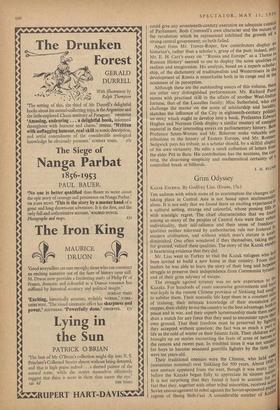Grim Odyssey
KAZAK EXODUS. By Godfrey Lias. (Evans, 15s.) THE sadness with which some of us contemplate the changes 11°,',v taking place in Central Asia is not based upon sentimentall!i alone. It is not only that we found there an exciting experience ° a cultural setting, strange and colourful, whose- passing fills esd with nostalgic regret. The chief characteristics that we foes, among so many of the peoples of Central Asia were their robus' individuality, their self-reliance and their sense of freedool", qualities neither tolerated by authoritarian rule nor fostered by modern civilisation, and without which man's stature is sure` diminished. One often wondered if they themselves, taking them . for granted, valued these qualities. The story of the Kazak exodo is heartening evidence that they did. Mr. Lias went to Turkey to visit the Kazak refugees who br been invited to build a new home in that country. From the leaders he was able to learn the story of their long and holole",, struggle to preserve their independence from Communist tyrann:' and of their grim odyssey of escape. The struggle against tyranny was no new experience to Kazaks. For hundreds of years successive governments and 10ct war-lofds in the remote Chinese province of Sinkiang had sours to subdue them. Their nomadic life kept them in a constant al$d of training; their intimate knowledge of their mountains 1111,0 steppes, their ability to use the country to the best advantage, botiii'e peace and in war, and their superb horsemanship made them ant than a match for any force that they used to encounter upon Ora own ground. That their freedom must be preserved by flgilljof they accepted without question; the fact was as much a Part re life as the cold of winter or their Islamic faith. Their children o wei brought up on stories recounting the feats of arms of heroes ai the remote and recent past. In troubled times it was not unnt.ticy for boys to become seasoned guerrilla fightdrs by the time tn were ten years old.
Their traditional enemies were the Chinese, who held t
61/0 (sometimes nominal) over Sinkiang for 500 years. About 193u4s new menace appeared from the west, though it was many yea before the Kazaks began fully to appreciate its sinister nature' ;e
It is not surprising that they found it hard to account fat' b
si fact that they, together with other tribal minorities, received acts Soviet encouragement to rebel against the Soviet-sponsored pup rito regime of Sheng Shih-t'sai. A considerable number of KO'
fell for Soviet blandishments and became harnessed to the Com- munist machine; many fled to Tibet and thence to India, a migration which took place more than ten years before the one described in this book.
Sheng's `reign' of terror' was followed in 1942 by a respite occasioned by the recession of Soyiet influence in Sinkiang. But, with the rapid disintegration of Nationalist China, it could not last, and by the end of the decade. the `free' Kazaks were faced squarely with the concerted power of the Soviet Union and Communist China. The alternative of submission seems hardly to have occurred to them, for, in the words of one of their leaders to the author, `It is better to die than to live as an animal. An animal looks to man as though he were God. It is not right that a man should look to other men in such a fashion.' But though the Kaiaks were splendid guerrilla fighters, they were greatly handicapped by the necessity of protecting their great flocks a Id herds, upon which they were utterly dependent: Their opponents, on the other hand, not content with their vast numerical superiority and the advantage of air power, adopted such tactics as forcing the Kazaks out of their strongholds by poisoning their water supplies. At length the nomads, realising the hopelessness of their situation, began their magnificent fighting retreat.
Lias presents in narrative form a convincing and, on the w oul e, accurate picture of the character of the Kazaks, their
customs and their biblical mode of living. His attempt to unravel lhe tangled web of political intrigue during the two decades prior te the 1 . nal establishment of Communist control in Sinkiang is
y somewhat confusing. But the scene was far more confus- '8 contemporary observers, and the author provides a plaus- ible ex
planation of a number of mysterious events, which
illustrates the subtlety of Communist tactics. The story of the exodus itself, across formidable deserts and over the vast, un- explored, ranges of Tibet, under constant attack, both from Coin-
h• iorces and from hostile tribes, is well told. It is good to
"ave a record of such amazing for and endurance.
ERIC SHIPTON



































 Previous page
Previous page